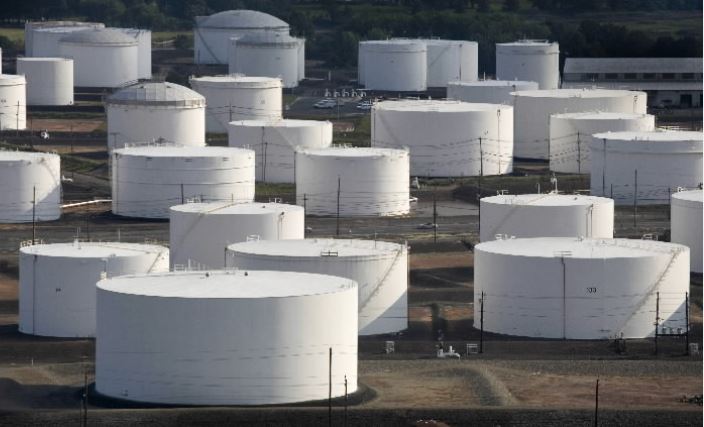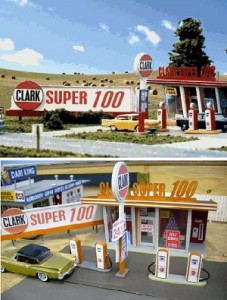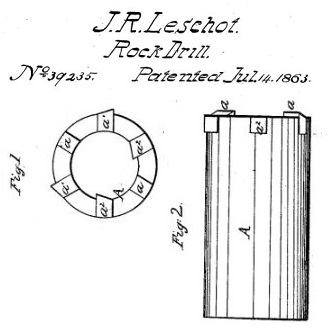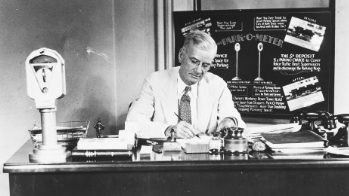July 10, 2000 – DOE establishes Home Heating Oil Reserve –
President Bill Clinton directed Energy Secretary Bill Richardson to establish the Northeast Home Heating Oil Reserve (NEHHOR) for use during severe winters and other supply emergencies. The reserve of 2 million barrels was expected to last 10 days, the time required for tankers to bring more heating oil from the Gulf of Mexico to New York Harbor.

One million barrels of NEHHOR oil are stored in commercial facilities in the Boston area (400,000), the New York Harbor area (300,000), and 300,000 barrels in Groton, Connecticut. Photo courtesy DOE.
Formally established by the George W. Bush Administration in 2001 and separated from the Strategic Petroleum Reserve, NEHHOR would be reduced in size to 1 million barrels a decade later. The stored fuel was changed from No. 2 heating oil to cleaner burning, ultra-low sulfur distillate (diesel) held in New England commercial storage facilities.
The first emergency use of NEHHOR took place in 2012, following Hurricane Sandy’s landfall in northeastern states. But with no drawdown since, “the utility and benefits provided by the NEHHOR have been questioned,” according to an August 2022 report by the Congressional Research Service (CRS).
July 11, 2008 – World Oil Price hits Historic High
The price of oil reached a record high of $147.27 a barrel before dropping back to $145.08. Prices on the New York Mercantile Exchange had peaked at $145.29 a barrel eight days earlier. As supply fears subsided, oil prices fell below $37 a barrel by early 2009. Rising global demand beginning in 2011 resulted in prices peaking at $107.95 per barrel in June 2014, before falling more than 50 percent by the end of 2015.
Following Russia’s invasion of Ukraine in February 2022, the price of West Texas Intermediate (WTI) reached $113.66 per barrel before declining to near $100 in July 2022. On July 6, 2023, the WTI wholesale spot price was $71.76, according to the Energy Information Administration (EIA).
July 11, 2013 – Drop of Pitch drips After 69 Years
Physicists at Trinity College Dublin photographed a falling drip of pitch — “one of the most anticipated drips in science,” according to the journal Nature.

Pitch (bitumen) is a naturally occurring hydrocarbon that flows very, very slowly.
Set up in 1944, the pitch-drop experiment demonstrated the high viscosity (low fluidity) of pitch, a natural hydrocarbon also known as bitumen or asphalt that appears solid at room temperature, but is flowing extremely slowly.
“The Trinity College team has estimated the viscosity of the pitch by monitoring the evolution of this one drop, and puts it in the region of two million times more viscous than honey, or 20 billion times the viscosity of water, ” the magazine noted. Another “Pitch Drop Experiment” that began 1927 continues at an Australian university.
Learn more in Asphalt paves the Way.
July 12, 1934 – Emory Clark launches “Clark Super 100” Stations
Two years after paying $14 for a closed, one-pump gas station in Milwaukee, Wisconsin, Emory Clark incorporated what would become the Clark Oil & Refining Corporation.
Clark established a network of simplified filling stations that focused on selling premium gasoline only, Super 100 Premium. His marketing strategy began with eliminated common services like maintenance, engine repair, and tire changing.

Founded in 1934, Clark operated about 1,500 gas stations by 1970.
Sales reached $21.1 million in 1949, and by 1953 the company operated more than 150 service stations in the Midwest under the brand name Clark Super 100. After purchasing a refinery at Wood River, Illinois, in 1967, Clark began selling high-octane gas from 1,500 stations.
In 1981, the Clark family sold their company holdings, which began with Emory T. Clark’s $14 purchase, to Missouri-based Apex Oil for $483 million.
July 14, 1863 – Patent issued for “Tool for Boring Rock”
French tunnel engineer Rodolphe Leschot received a U.S. patent for a “Tool for Boring Rock.” His concept included a ring of industrial-grade diamonds on the end of a tubular drill rod designed to cut a cylindrical core. Water pumped through the drill rod washed away cuttings and cooled the bit. Leschot’s system proved successful in drilling blast holes for tunneling Mount Cenis on the France-Italy border.

French engineer Rodolphe Leschot’s cutting-edge 1863 drilling technology.
The use of diamond bits in oil well drilling was being examined in the petroleum regions of western Pennsylvania after the Civil War. “It is not known if there is any connection between the 1865 experimental diamond core drilling in the Pennsylvania oil region and the Leschot blast hole drilling in France in 1863,” oil historian Sam Pees noted in 2004.
Learn more about Making Hole – Drilling Technology.
July 14, 1891 – Rockefeller expands Oil Tank Car Empire
John D. Rockefeller incorporated Union Tank Line Company in New Jersey and transferred his fleet of several thousand oil tank cars to the Standard Oil Trust. He then systematically acquired control of all but 200 of America’s 3,200 existing oil tank cars. By 1904, his rolling fleet had grown to 10,000.

By 1904, Standard Oil’s railroad tank car fleet had grown to 10,000.
Union Tank Line Company shipped only Standard Oil products until 1911, when the U.S. Supreme Court mandated dissolution of Standard Oil. The new shipping company changed its name to Union Tank Car Company (its official mark kept Standard’s UTL or UTLX). Union introduced a 50,000-gallon tank car in 1963, the largest in rail service.
Learn more about the early days of transporting petroleum in Densmore Oil Tank Car.
July 16, 1907 – Carl Baker’s Casing Shoe advances Oilfield Technology
After drilling wells in booming Kern River oilfields, R. Carlton “Carl” Baker of Coalinga, California, patented what would become the Baker casing shoe, a device that increased efficiency and reliability for ensuring oil flowed through a well. Baker, who had founded the Coalinga Oil Company in 1903, by 1913 established the Baker Casing Shoe Company (renamed Baker Tools two years later).
The prolific inventor opened his first manufacturing plant in Coalinga before moving headquarters to Los Angeles in the 1930s. Baker Tools became Baker International in 1976 and Baker Hughes after a 1987 merger with the Hughes Tool Company. General Electric Purchased Baker Hughes in 2017, but divested its status as majority shareholder two years later.
Learn more in Carl Baker and Howard Hughes.
July 16, 1926 – Oil Discovery launches Greater Seminole Area Boom
Three years after an oil well was completed near Bowlegs, Oklahoma, a gusher south of Seminole revealed the true oil potential of Seminole County. The Fixico No. 1 well penetrated the prolific Wilcox Sands formation at 4,073 feet deep.
Drilled by R.F. Garland and his Independent Oil Company, the well was among more than 50 Greater Seminole Area oil reservoirs discovered; six were giants that produced more than one million barrels of oil each. With the Oklahoma City oilfield added in 1928, Oklahoma became the largest supplier of oil in the world by 1935.
Learn more in Seminole Oil Boom.
July 16, 1935 – Oklahoma Publisher produces First Parking Meter
As the booming Oklahoma City oilfield added to the congestion of cars downtown, the world’s first parking meter was installed at the corner of First Street and Robinson Avenue. Carl C. Magee, publisher of the Oklahoma News, designed the Park-O-Meter No. 1, today preserved by the Oklahoma Historical Society.

Oklahoma college students helped Carl Magee design the Park-O-Meter No. 1. Photo courtesy Oklahoma Historical Society.
“The meter charged five cents for one hour of parking, and naturally citizens hated it, viewing it as a tax for owning a car,” noted historian Josh Miller in 2012. “But retailers loved the meter, as it encouraged a quick turnover of customers.”
Park-O-Meters were manufactured by MacNick Company of Tulsa, maker of timing devices used to explode nitroglycerin in oil and natural gas wells. A local oilfield service competitor of MacNick was the Zero Hour Bomb Company — Zebco.
July 16, 1969 – Kerosene fuels launch of Saturn V Moon Rocket
A 19th century petroleum product made America’s 1969 moon landing possible. Kerosene powered the first-stage rocket engines of the Saturn V when it launched the Apollo 11 mission on July 16. Four days later, astronaut Neil Armstrong announced, “Houston, Tranquility Base here. The Eagle has landed.”

Powered by five first-stage engines fueled by “rocket grade” kerosene, the Saturn V remains the tallest, heaviest and most powerful rocket ever built. Photos courtesy Nasa.
Five engines of the Saturn V’s first stage burned “Rocket Grade Kerosene Propellant” at 2,230 gallons per second — generating almost eight million pounds of thrust. The fuel was a highly refined kerosene RP-1 (Rocket Propellant-1) that began as “coal oil” for lamps.
Canadian physician and geologist Abraham Gesner first refined the fuel from coal in 1846. He coined the term kerosene from the Greek word keros (wax). RP-1 continues to fuel many rockets. Beginning in June 2010, SpaceX Falcon 9 rockets have used nine engines burning the kerosene fuel.
Learn more in Kerosene Rocket Fuel.
_______________________
Recommended Reading: Down the Asphalt Path: The Automobile and the American City (1994); Pump and Circumstance: Glory Days of the Gas Station
(1993); A History of the Greater Seminole Oil Field
(1981); The United States of Awesome: Fun, Fascinating and Bizarre Trivia about the Greatest Country in the Universe (2012); Stages to Saturn: A Technological History of the Apollo/Saturn Launch Vehicles
(2003). As an Amazon Associate, AOGHS earns a commission from qualifying purchases.
_______________________
The American Oil & Gas Historical Society (AOGHS) preserves U.S. petroleum history. Become an AOGHS annual supporting member and help maintain this energy education website and expand historical research. For more information, contact bawells@aoghs.org. © 2023 Bruce A. Wells. All rights reserved.


